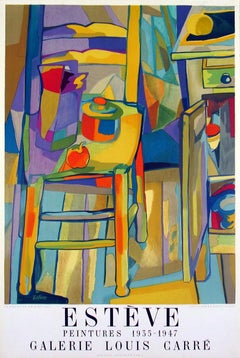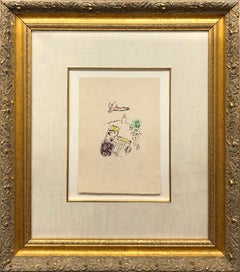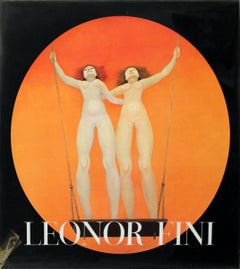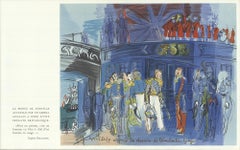Want more images or videos?
Request additional images or videos from the seller
1 of 8
1959 Pablo Picasso 'Bullfighter' Lithograph1959
1959
Price:$67
$75List Price
About the Item
- Creation Year:1959
- Dimensions:Height: 14.5 in (36.83 cm)Width: 10.5 in (26.67 cm)Depth: 0.1 in (2.54 mm)
- Medium:
- Movement & Style:
- After:(after) Pablo Picasso (1881 - 1973, Spanish)
- Period:
- Condition:A-: Near Mint, very light signs of handling.
- Gallery Location:Brooklyn, NY
- Reference Number:Seller: YY25361stDibs: LU129418664282
About the Seller
4.9
Platinum Seller
Premium sellers with a 4.7+ rating and 24-hour response times
Established in 1992
1stDibs seller since 2019
2,718 sales on 1stDibs
Typical response time: 1 hour
Authenticity Guarantee
In the unlikely event there’s an issue with an item’s authenticity, contact us within 1 year for a full refund. DetailsMoney-Back Guarantee
If your item is not as described, is damaged in transit, or does not arrive, contact us within 7 days for a full refund. Details24-Hour Cancellation
You have a 24-hour grace period in which to reconsider your purchase, with no questions asked.Vetted Professional Sellers
Our world-class sellers must adhere to strict standards for service and quality, maintaining the integrity of our listings.Price-Match Guarantee
If you find that a seller listed the same item for a lower price elsewhere, we’ll match it.Trusted Global Delivery
Our best-in-class carrier network provides specialized shipping options worldwide, including custom delivery.You May Also Like
Giorgio de Chirico 1960s Original Signed Lithography
By Giorgio De Chirico
Located in Roma, IT
Giorgio de Chirico 1960s Original Signed Lithography
Lithograph with golden yellow background
Signed in pencil lower left ‘P d A’ Artist's proof
Signed in pencil lower right ‘G. De ...
Category
1950s Modern Animal Prints
Materials
Paper, Lithograph
$2,115
H 27.56 in W 19.69 in D 0.79 in
British Post Office Greetings Telegrams (1935-1978), after various artists
Located in London, GB
British Post Office Greetings Telegrams (1935-1978), after various artists
photolithograph
dimensions, including frames:
33 x Telegram 9 ¾ x 11 ⅞ in. (24.8 x 30.1 cm.)
31 x Telegram 10 ½ x 12 in. (26.8 x 30.5 cm.)
12 x Telegram 11 ½ x 18 in. (29.2 x 45.7 cm.) and similar
12 x Telegram 9 x 11 ½ in. (22.9 x 29.2 cm.)
1 x Telegram 11 ¾ x 12 ¾ in. (29.8 x 32.4 cm.)
1 x Telegram 9 x 10 ⅜ in. (22.9 x 26.3 cm.)
1 x Telegram 8 x 10 ½ in. (20.3 x 26.7 cm.)
A set of ninety-one (91)
The historical equivalent of a text or WhatsApp message, the first telegram was sent in code in 1844 from Washington to Baltimore by Samuel Morse, asking “What hath God wrought?” By 1870 (the year that the British General...
Category
20th Century Modern Figurative Prints
Materials
Lithograph
$14,432
H 11 in W 18 in
Descente aux enfers
By Georges Braque
Located in Paris, FR
Lithograph on Japan Paper, 1961
handsigned by the artist in pencil
23 x 19 cm (image) - 32 x 25 cm (sheet)
very good condition
LCD2804
Category
1960s Modern Figurative Prints
Materials
Lithograph
Memnon - after Georges Braque - Lithograph - 1988 - Figurative Print
By (after) Georges Braque
Located in Sint-Truiden, BE
Color lithograph after a gouache by Georges Braque from the edition of 398 published by Armand & Georges Israel in 1988. Printed signature.
Artwork entirely made in France: from th...
Category
1980s Modern Figurative Prints
Materials
Lithograph
$411
H 17.72 in W 22.84 in
Hébé - after Georges Braque - Lithograph - 1988 - Figurative Print
By (after) Georges Braque
Located in Sint-Truiden, BE
Color lithograph after a gouache by Georges Braque from the edition of 398 published by Armand & Georges Israel in 1988. Printed signature.
Artwork en...
Category
1980s Modern Figurative Prints
Materials
Lithograph
$411
H 22.84 in W 17.72 in
"Mother"
By Raphael Soyer
Located in Southampton, NY
Signed in pencil lower right AP (artist proof)lower left
Sight size 18 x 12 in
Overall size in museum quality matted frame 30 x 23 in
Same lithograph is in permanent collection of th...
Category
Mid-20th Century Modern Figurative Prints
Materials
Lithograph
Marc Chagall - Bateau Mouche au bouquet - Original Lithograph
By Marc Chagall
Located in Collonge Bellerive, Geneve, CH
Marc Chagall
Original Lithograph
Title: Bateau Mouche au bouquet
1963
Dimensions: 39 x 30 cm
Edition: 180
Unsigned as issued.
From Regards sur Paris
Published by André Sauret
Condit...
Category
1960s Modern Figurative Prints
Materials
Lithograph
$2,349
H 15.36 in W 11.82 in D 0.04 in
Marc Chagall - Moses with Tablets of Stone - Original Lithograph
By Marc Chagall
Located in Collonge Bellerive, Geneve, CH
Marc Chagall, Original Lithograph depicting an instant of the Bible.
Technique: Original lithograph in colours
Year: 1956
Sizes: 35,5 x 26 cm / 14" x 10.2" (sheet)
Published by: Éditions de la Revue Verve, Tériade, Paris
Printed by: Atelier Mourlot, Paris
Documentation / References: Mourlot, F., Chagall Lithograph [II] 1957-1962, A. Sauret, Monte Carlo 1963, nos. 234 and 257
Marc Chagall (born in 1887)
Marc Chagall was born in Belarus in 1887 and developed an early interest in art. After studying painting, in 1907 he left Russia for Paris, where he lived in an artist colony on the city’s outskirts. Fusing his own personal, dreamlike imagery with hints of the fauvism and cubism popular in France at the time, Chagall created his most lasting work—including I and the Village (1911)—some of which would be featured in the Salon des Indépendants exhibitions. After returning to Vitebsk for a visit in 1914, the outbreak of WWI trapped Chagall in Russia. He returned to France in 1923 but was forced to flee the country and Nazi persecution during WWII. Finding asylum in the U.S., Chagall became involved in set and costume design before returning to France in 1948. In his later years, he experimented with new art forms and was commissioned to produce numerous large-scale works. Chagall died in St.-Paul-de-Vence in 1985.
The Village
Marc Chagall was born in a small Hassidic community on the outskirts of Vitebsk, Belarus, on July 7, 1887. His father was a fishmonger, and his mother ran a small sundries shop in the village. As a child, Chagall attended the Jewish elementary school, where he studied Hebrew and the Bible, before later attending the Russian public school. He began to learn the fundamentals of drawing during this time, but perhaps more importantly, he absorbed the world around him, storing away the imagery and themes that would feature largely in most of his later work.
At age 19 Chagall enrolled at a private, all-Jewish art school and began his formal education in painting, studying briefly with portrait artist Yehuda Pen. However, he left the school after several months, moving to St. Petersburg in 1907 to study at the Imperial Society for the Protection of Fine Arts. The following year, he enrolled at the Svanseva School, studying with set designer Léon Bakst, whose work had been featured in Sergei Diaghilev's Ballets Russes. This early experience would prove important to Chagall’s later career as well.
Despite this formal instruction, and the widespread popularity of realism in Russia at the time, Chagall was already establishing his own personal style, which featured a more dreamlike unreality and the people, places and imagery that were close to his heart. Some examples from this period are his Window Vitebsk (1908) and My Fianceé with Black Gloves (1909), which pictured Bella Rosenfeld, to whom he had recently become engaged.
The Beehive
Despite his romance with Bella, in 1911 an allowance from Russian parliament member and art patron Maxim Binaver enabled Chagall to move to Paris, France. After settling briefly in the Montparnasse neighborhood, Chagall moved further afield to an artist colony known as La Ruche (“The Beehive”), where he began to work side by side with abstract painters such as Amedeo Modigliani and Fernand Léger as well as the avant-garde poet Guillaume Apollinaire. At their urging, and under the influence of the wildly popular fauvism and cubism, Chagall lightened his palette and pushed his style ever further from reality. I and the Village (1911) and Homage to Apollinaire (1912) are among his early Parisian works, widely considered to be his most successful and representative period.
Though his work stood stylistically apart from his cubist contemporaries, from 1912 to 1914 Chagall exhibited several paintings at the annual Salon des Indépendants exhibition, where works by the likes of Juan Gris, Marcel Duchamp and Robert Delaunay were causing a stir in the Paris art world. Chagall’s popularity began to spread beyond La Ruche, and in May 1914 he traveled to Berlin to help organize his first solo exhibition, at Der Sturm Gallery. Chagall remained in the city until the highly acclaimed show opened that June. He then returned to Vitebsk, unaware of the fateful events to come.
War, Peace and Revolution
In August 1914 the outbreak of World War I precluded Chagall’s plans to return to Paris. The conflict did little to stem the flow of his creative output, however, instead merely giving him direct access to the childhood scenes so essential to his work, as seen in paintings such as Jew in Green (1914) and Over Vitebsk (1914). His paintings from this period also occasionally featured images of the war’s impact on the region, as with Wounded Soldier (1914) and Marching (1915). But despite the hardships of life during wartime, this would also prove to be a joyful period for Chagall. In July 1915 he married Bella, and she gave birth to a daughter, Ida, the following year. Their appearance in works such as Birthday (1915), Bella and Ida by the Window (1917) and several of his “Lovers” paintings give a glimpse of the island of domestic bliss that was Chagall’s amidst the chaos.
To avoid military service and stay with his new family, Chagall took a position as a clerk in the Ministry of War Economy in St. Petersburg. While there he began work on his autobiography and also immersed himself in the local art scene, befriending novelist Boris Pasternak, among others. He also exhibited his work in the city and soon gained considerable recognition. That notoriety would prove important in the aftermath of the 1917 Russian Revolution when he was appointed as the Commissar of Fine Arts in Vitebsk. In his new post, Chagall undertook various projects in the region, including the 1919 founding of the Academy of the Arts. Despite these endeavors, differences among his colleagues eventually disillusioned Chagall. In 1920 he relinquished his position and moved his family to Moscow, the post-revolution capital of Russia.
In Moscow, Chagall was soon commissioned to create sets and costumes for various productions at the Moscow State Yiddish...
Category
1950s Modern Figurative Prints
Materials
Lithograph
$1,526
H 13.98 in W 10.24 in D 0.04 in
Marc Chagall - Moses - Original Lithograph
By Marc Chagall
Located in Collonge Bellerive, Geneve, CH
Marc Chagall, Original Lithograph depicting an instant of the Bible.
Technique: Original lithograph in colours
Year: 1956
Sizes: 35,5 x 26 cm / 14" x 10.2" (sheet)
Published by: Éditions de la Revue Verve, Tériade, Paris
Printed by: Atelier Mourlot, Paris
Documentation / References: Mourlot, F., Chagall Lithograph [II] 1957-1962, A. Sauret, Monte Carlo 1963, nos. 234 and 257
Marc Chagall (born in 1887)
Marc Chagall was born in Belarus in 1887 and developed an early interest in art. After studying painting, in 1907 he left Russia for Paris, where he lived in an artist colony on the city’s outskirts. Fusing his own personal, dreamlike imagery with hints of the fauvism and cubism popular in France at the time, Chagall created his most lasting work—including I and the Village (1911)—some of which would be featured in the Salon des Indépendants exhibitions. After returning to Vitebsk for a visit in 1914, the outbreak of WWI trapped Chagall in Russia. He returned to France in 1923 but was forced to flee the country and Nazi persecution during WWII. Finding asylum in the U.S., Chagall became involved in set and costume design before returning to France in 1948. In his later years, he experimented with new art forms and was commissioned to produce numerous large-scale works. Chagall died in St.-Paul-de-Vence in 1985.
The Village
Marc Chagall was born in a small Hassidic community on the outskirts of Vitebsk, Belarus, on July 7, 1887. His father was a fishmonger, and his mother ran a small sundries shop in the village. As a child, Chagall attended the Jewish elementary school, where he studied Hebrew and the Bible, before later attending the Russian public school. He began to learn the fundamentals of drawing during this time, but perhaps more importantly, he absorbed the world around him, storing away the imagery and themes that would feature largely in most of his later work.
At age 19 Chagall enrolled at a private, all-Jewish art school and began his formal education in painting, studying briefly with portrait artist Yehuda Pen. However, he left the school after several months, moving to St. Petersburg in 1907 to study at the Imperial Society for the Protection of Fine Arts. The following year, he enrolled at the Svanseva School, studying with set designer Léon Bakst, whose work had been featured in Sergei Diaghilev's Ballets Russes. This early experience would prove important to Chagall’s later career as well.
Despite this formal instruction, and the widespread popularity of realism in Russia at the time, Chagall was already establishing his own personal style, which featured a more dreamlike unreality and the people, places and imagery that were close to his heart. Some examples from this period are his Window Vitebsk (1908) and My Fianceé with Black Gloves (1909), which pictured Bella Rosenfeld, to whom he had recently become engaged.
The Beehive
Despite his romance with Bella, in 1911 an allowance from Russian parliament member and art patron Maxim Binaver enabled Chagall to move to Paris, France. After settling briefly in the Montparnasse neighborhood, Chagall moved further afield to an artist colony known as La Ruche (“The Beehive”), where he began to work side by side with abstract painters such as Amedeo Modigliani and Fernand Léger as well as the avant-garde poet Guillaume Apollinaire. At their urging, and under the influence of the wildly popular fauvism and cubism, Chagall lightened his palette and pushed his style ever further from reality. I and the Village (1911) and Homage to Apollinaire (1912) are among his early Parisian works, widely considered to be his most successful and representative period.
Though his work stood stylistically apart from his cubist contemporaries, from 1912 to 1914 Chagall exhibited several paintings at the annual Salon des Indépendants exhibition, where works by the likes of Juan Gris, Marcel Duchamp and Robert Delaunay were causing a stir in the Paris art world. Chagall’s popularity began to spread beyond La Ruche, and in May 1914 he traveled to Berlin to help organize his first solo exhibition, at Der Sturm Gallery. Chagall remained in the city until the highly acclaimed show opened that June. He then returned to Vitebsk, unaware of the fateful events to come.
War, Peace and Revolution
In August 1914 the outbreak of World War I precluded Chagall’s plans to return to Paris. The conflict did little to stem the flow of his creative output, however, instead merely giving him direct access to the childhood scenes so essential to his work, as seen in paintings such as Jew in Green (1914) and Over Vitebsk (1914). His paintings from this period also occasionally featured images of the war’s impact on the region, as with Wounded Soldier (1914) and Marching (1915). But despite the hardships of life during wartime, this would also prove to be a joyful period for Chagall. In July 1915 he married Bella, and she gave birth to a daughter, Ida, the following year. Their appearance in works such as Birthday (1915), Bella and Ida by the Window (1917) and several of his “Lovers” paintings give a glimpse of the island of domestic bliss that was Chagall’s amidst the chaos.
To avoid military service and stay with his new family, Chagall took a position as a clerk in the Ministry of War Economy in St. Petersburg. While there he began work on his autobiography and also immersed himself in the local art scene, befriending novelist Boris Pasternak, among others. He also exhibited his work in the city and soon gained considerable recognition. That notoriety would prove important in the aftermath of the 1917 Russian Revolution when he was appointed as the Commissar of Fine Arts in Vitebsk. In his new post, Chagall undertook various projects in the region, including the 1919 founding of the Academy of the Arts. Despite these endeavors, differences among his colleagues eventually disillusioned Chagall. In 1920 he relinquished his position and moved his family to Moscow, the post-revolution capital of Russia.
In Moscow, Chagall was soon commissioned to create sets and costumes for various productions at the Moscow State Yiddish...
Category
1950s Modern Figurative Prints
Materials
Lithograph
Pablo Picasso - Les Banderillas - Original Lithograph
By Pablo Picasso
Located in Collonge Bellerive, Geneve, CH
Original Lithograph by Picasso
Atelier Mourlot.
Paper: Vélin.
Dimensions : 9 5/8 x 12 7/16 inches
Bloch 1017; Cramer 113; Mourlot 350
Category
1960s Modern Animal Prints
Materials
Lithograph
$1,586
H 10.24 in W 12.6 in D 0.04 in
More From This Seller
View AllEsteve- Peintures, 1947 Stone Lithograph Vintage
By Maurice Estève
Located in Brooklyn, NY
Printed by Mourlot for an Maurice Esteve exhibition held at the Galerie Louis Carre. Esteve is well-known for his rich colors similar to the fauvist mouvement of the early 20th centu...
Category
Mid-20th Century Modern Figurative Prints
Materials
Lithograph
$200 Sale Price
20% Off
Marc Chagall King David (Pink Bible) Stone Lithograph Mid Century Modern
By (after) Marc Chagall
Located in Brooklyn, NY
Lithograph printed on Japon paper, not signed and not numbered. The lithograph is cataloged number 721 in "Chagall-The Lithographs" by D.A.P. The overall outside dimensions are 26 x...
Category
1970s Modern Figurative Prints
Materials
Lithograph
$975 Sale Price
35% Off
Leonor Fini Peintures
By Leonor Fini
Located in Brooklyn, NY
Printed in Switzerland and published by La Guilde du Livre and Clairefontaine, Lausanne in 1972, this third edition (#781) is a beautifully produced volume showcasing the works of Le...
Category
1980s Modern Figurative Prints
Materials
Offset, Lithograph
$240 Sale Price
20% Off
Le Prince de Joinville recu a bord d'une fregate anglaise
By Raoul Dufy
Located in Brooklyn, NY
This lithograph titled Le Prince de Joinville reçu à bord d'une frégate anglaise is part of the book Lettre à mon Peintre by Marcelle Oury. The lithograph is printed on high-quality ...
Category
1960s Impressionist Figurative Prints
Materials
Lithograph
$100 Sale Price
20% Off
Botero-Mozart '91 Salzburg Vintage lithograph
By Fernando Botero
Located in Brooklyn, NY
Original limited edition poster for Mozart '91, Salzburg.
Published by Marlborough Gallery, New York. Lithograph printed on Arches paper with deckled edges.
This original lithograph...
Category
1990s Contemporary Figurative Prints
Materials
Lithograph
1988 'Climbing' Hand Signed
By Mark Kostabi
Located in Brooklyn, NY
In his print Climbing, Mark Kostabi explores the theme of corporate ambition, depicting faceless characters "climbing the corporate ladder" in his signature style. This early work re...
Category
1980s Contemporary Prints and Multiples
Materials
Black and White, Lithograph
$720 Sale Price
20% Off
Recently Viewed
View AllMore Ways To Browse
Vintage Fishing Lure Art
Vintage Gwr Posters
Vintage Posters Louvre
Vintage Robinson Crusoe
Vodka Poster
Vulture Painting
Warhol Jackie
Waterfowl Art
Whale Shark
William A Smith
Wpa Art California
Yayoi Kusama Signed Art
Zinkeisen Doris
16th Century Antiques
19th Century Oil Painting Of Greyhound
Abraham And Isaac
Antique Cavalier King Charles Spaniel Paintings
Antique Fox Hunting Paintings



